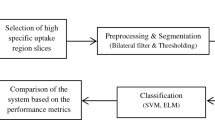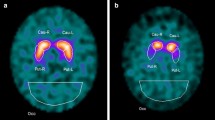Abstract
The absence of an effective cure to Parkinson as a neurodegenerative disease calls for early diagnosis and appropriate therapeutic process to provide patients with better quality of treatment. Therefore, to diagnose Parkinson’s Disease (PD) at its early stage, clinicians rely on visual observation of dopaminergic deficit in both caudate and putamen in the striatum region of the brain. SPECT images (Single Photon Emission Computed Tomography) are among functional neuroimaging scans that can show putamen and caudate, and hence help visualizing Dopamine deficit. In this work, we developed an automatic SPECT image model to classify patients as Healthy Control (HC) or Early PD, starting from Dicom SPECT images from PPMI (Parkinson’s Progression Markers Initiative) database to Machine learning classification. The approach we proposed starts with image processing of SPECT images, then extraction of boundary, radial, Striatal Binding Ratio (SBR) and threshold features, then classification using Support Vector Machine (SVM). To the best of our knowledge, no work in the literature has used this combination of the mentioned features together in the classification model. The use of this combination demonstrates promising results. We used a database of 526 images, with 130 HC and 396 PD. The results of our approach show that the Medium Gaussian SVM has a high performance with an accuracy of 97.3%, sensitivity of 95.3%, and specificity of 98%.
Access this chapter
Tax calculation will be finalised at checkout
Purchases are for personal use only
Similar content being viewed by others
References
Bhalchandra, N.A., Prashanth, R., Roy, S.D., Noronha, S.: Early detection of Parkinson’s disease through shape based features from \(^{123}\)i-ioflupane spect imaging. In: 2015 IEEE 12th International Symposium on Biomedical Imaging (ISBI), pp. 963–966 (2015). https://doi.org/10.1109/ISBI.2015.7164031
Booij, J.: [123i]fp-cit spect shows a pronounced decline of striatal dopamine transporter labelling in early and advanced parkinson’s disease. J. Neurol. Neurosurg. Psychiatry 62(2), 133–140 (1997). https://doi.org/10.1136/jnnp.62.2.133
Booth, T.C., Nathan, M., Waldman, A.D., Quigley, A.M., Schapira, A.H., Buscombe, J.: The role of functional dopamine-transporter SPECT imaging in parkinsonian syndromes. Part 1. Am. J. Neuroradiol. 36(2), 229–235 (2014). https://doi.org/10.3174/ajnr.a3970
De Lau, L.M., Breteler, M.M.: Epidemiology of parkinson’s disease. Lancet Neurol. 5(6), 525–535 (2006). https://doi.org/10.1016/s1474-4422(06)70471-9
Marek, K., et al.: The Parkinson progression marker initiative (PPMI). Prog. Neurobiol. 95(4), 629–635 (2011). https://doi.org/10.1016/j.pneurobio.2011.09.005
Martinez-Murcia, F.J., Górriz, J.M., Ramírez, J., Moreno-Caballero, M., Gómez-Río, M., Initiative, P.P.M.I.: Parametrization of textural patterns in \(^{123}\)i-ioflupane imaging for the automatic detection of parkinsonism. Nucl. med. phys. 41, 012502 (2014). https://doi.org/10.1118/1.4845115
Ortiz, A., Munilla, J., Martínez-Ibañez, M., Górriz, J., Ramírez, J., Salas-Gonzalez, D.: Parkinson’s disease detection using isosurfaces-based features and convolutional neural networks. Front. Neuroinform. 13, 48 (2019). https://doi.org/10.3389/fninf.2019.00048
Prashanth, R., Roy, S.D., Mandal, P.K., Ghosh, S.: High-accuracy classification of Parkinson’s disease through shape analysis and surface fitting in \(^{123}\)i-ioflupane spect imaging. IEEE J. Biomed. Health Inform. 21(3), 794–802 (2017). https://doi.org/10.1109/JBHI.2016.2547901
Prashanth, R., Roy, S.D., Mandal, P.K., Ghosh, S.: High-accuracy classification of parkinson’s disease through shape analysis and surface fitting in 123i-ioflupane spect imaging. IEEE J. Biomed. Health Inform. 21(3), 794–802 (2017). https://doi.org/10.1109/JBHI.2016.2547901
Rumman, M., Tasneem, A.N., Farzana, S., Pavel, M.I., Alam, A.M.: Early detection of parkinson’s disease using image processing and artificial neural network. In: 2018 Joint 7th International Conference on Informatics, Electronics Vision (ICIEV) and 2018 2nd International Conference on Imaging, Vision Pattern Recognition (icIVPR), pp. 256–261 (2018). https://doi.org/10.1109/ICIEV.2018.8641081
Shiiba, T., Arimura, Y., Nagano, M., Takahashi, T., Takaki, A.: Improvement of classification performance of Parkinson’s disease using shape features for machine learning on dopamine transporter single photon emission computed tomography. PLoS ONE 15(1), 1–12 (2020). https://doi.org/10.1371/journal.pone.0228289
Skidmore, F., et al.: Reliability analysis of the resting state can sensitively and specifically identify the presence of parkinson disease. NeuroImage 15(75), 249–261 (2013). https://doi.org/10.1016/j.neuroimage.2011.06.056
Towey, D.J., Bain, P.G., Nijran, K.S.: Automatic classification of \(^{123}\)i-fp-cit (datscan) spect images. Nucl. Med. Commun. 32, 699–707. https://doi.org/10.1097/MNM.0b013e328347cd09
Wang, W., Lee, J., Harrou, F., Sun, Y.: Early detection of Parkinson’s disease using deep learning and machine learning. IEEE Access 8, 147635–147646 (2020). https://doi.org/10.1109/access.2020.3016062
Author information
Authors and Affiliations
Corresponding author
Editor information
Editors and Affiliations
Rights and permissions
Copyright information
© 2022 The Author(s), under exclusive license to Springer Nature Switzerland AG
About this paper
Cite this paper
Boucherouite, J., Jilbab, A., Jbari, A. (2022). Automatic SPECT Image Processing for Parkinson’s Disease Early Detection. In: Hamlich, M., Bellatreche, L., Siadat, A., Ventura, S. (eds) Smart Applications and Data Analysis. SADASC 2022. Communications in Computer and Information Science, vol 1677. Springer, Cham. https://doi.org/10.1007/978-3-031-20490-6_2
Download citation
DOI: https://doi.org/10.1007/978-3-031-20490-6_2
Published:
Publisher Name: Springer, Cham
Print ISBN: 978-3-031-20489-0
Online ISBN: 978-3-031-20490-6
eBook Packages: Computer ScienceComputer Science (R0)




